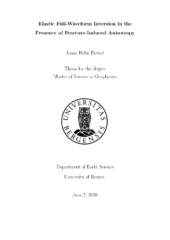Elastic Full-Waveform Inversion in the Presence of Fracture-Induced Anisotropy
Master thesis
Permanent lenke
https://hdl.handle.net/1956/22850Utgivelsesdato
2020-06-24Metadata
Vis full innførselSamlinger
- Master theses [106]
Sammendrag
Seismic imaging of the subsurface is essential in both the exploration and production of hydrocarbon reservoirs. Seismic full-waveform modelling and inversion methods can be used to obtain high-resolution images of the elastic properties. This work aims to develop further methods for non-linear elastic waveform inversion in anisotropic media associated with fractures. Based on previous research, the goal is to investigate which approach is the most reliable at estimating stiffness parameters. In this context, the rock physics t-matrix method was used to represent the stiffness perturbation due to fractures in a complex porous medium. The elastodynamic wave equation was solved using the full integral-equation solution of the Lippmann-Schwinger type. The frequency-domain scattered wavefield was used as synthetic data, to simulate the particle displacement from a fracture-induced anisotropic medium. Elastic Full-Waveform Inversion (FWI) makes use of all the information in the wavefield and is implemented by using the distorted Born iterative method (DBI). The DBI method is consistent with the Gauss-Newton iterative method and was performed using the self-adaptive regularisation scheme. For each iteration, both the Green's function and the sensitivity matrix were updated for the actual medium. Two models with different geological features, i.e. the syncline and anticline model, were used in the synthetic numerical experiments to simulate a fractured reservoir with transversely isotropic symmetry. Different levels of noise, as well as source-configurations, were investigated. For the models considered in this work, fracture-based inversion results were shown to match the actual model better than the stiffness-based inversion. When evaluating the results for noisy data of 40 dB SNR, it is evident that the stiffness-inversion is insufficient, particularly for the C13 parameter, when compared to fracture-inversion. On this basis, inverting for fracture parameters is recommended when characterising a reservoir associated with fractures. Future research is needed to identify more desirable fracture models and more efficient calculation of the full integral-equation solution.
